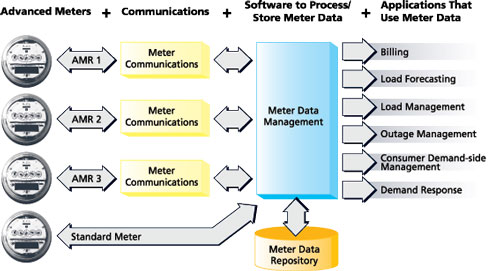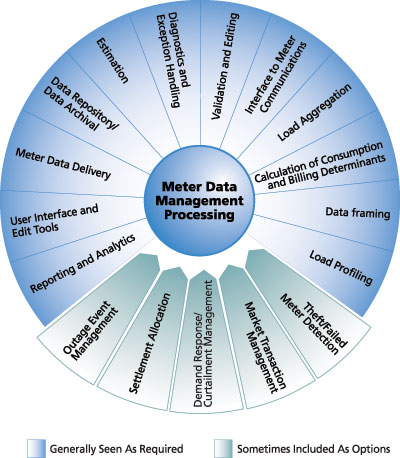
The past year has seen a dramatic change in the metering market.
Previously, utilities faced questions about cost-justifying Automated Meter Reading (AMR)—projects that reduced personnel and insurance costs by substituting drive-by or other data gathering devices for human meter readers.
Today, discussion is all about Advanced Metering Infrastructure (AMI). How quickly should utilities move forward with systems that combine time-of-use or interval meters with two-way communications, large-scale repositories, and new data management approaches? Will AMI live up to its promises to increase significantly the accuracy of load forecasting and management, extend demand/response programs to new audiences, improve outage response, and cut field workforce costs?
And how should utilities with existing AMR projects—or near-term plans to implement them—respond to this relatively sudden change in the landscape?
One prudent step is to weigh the costs of AMR and its benefits against a careful and realistic business case for moving ahead into more advanced AMI. (For a discussion of approaches to business case development, see “Coping with Smart Metering Uncertainties “ in the September/ October issue.)
Equally important is assessing the two major risks that lie clearly outside the utility’s current knowledge and control:
- The risk that AMI technology may not be mature enough to make a significant investment appear prudent over the time period during which it is amortized.
- The risk that AMI programs cost-justified in part on anticipated consumer or business community behavior that may not occur. If cost justification relies, for instance, on consumer participation in demand-response programs or on the development of third-party energy efficiency and management services, might utilities be subjected to regulatory criticism and cost disallowances if that behavior is other than anticipated?
This article explores these risks and suggests ways that utilities might be able to minimize them while still preparing to capture AMI’s many benefits for their stakeholders.
Technology Risk
Let’s take the technology dilemma first.
Advanced metering, with customer-site costs in the range of US$ 1,000 or more, has long been a viable and cost-effective approach for large commercial and industrial establishments. It has fostered the development and dissemination of equipment like chillers that use off-peak energy for on-peak consumption. It has encouraged the growth of distributed energy. And it has enabled states like New York to establish day-ahead hourly pricing programs to ensure that the bills of the state’s largest electricity users reflect actual costs.
Interval meters for residential consumers are a more recent phenomenon, made possible in part by the remarkable drop in metering technology costs—now frequently cited at US$ 150(1) or less. Further price drops are almost universally predicted. But exactly how low will they go? Some predict a 50 percent drop within the next year.
There is a danger in committing too early to today’s technology. “Policy is now catching up with technology maturity,” Gartner’s Zarko Sumic and James Spiers noted in a presentation last September; “however, if pushed too far, it could force premature technology choices that may prove to be inefficient and ineffective for future applications and consumer welfare.” They further stated, “Betting too early can lock into technology that will not serve future requirements.”
Meter technology is not the only element subject to change. Software and communications vendors are scrambling to introduce new product variants that respond to the growing AMI marketplace. Products are being reintroduced with “smart metering” labels. North American and international standards2 are emerging. Meter retrofits are being hailed as a salvation by some, pooh-poohed by others. Every week brings announcements of new advanced-metering alliances among hardware, software, and communications companies.
Product stability is not the only issue. As AMR guru Howard Scott warned last year, “[I]t is reasonable to assume that the number of auto¬mated metering vendors will shrink.”(2)
Scott also warns that product footprints may change rapidly. Why, he asks, should vendors “produce multiple software packages that then need to be supported? Isn’t it more efficient to build one common software package that might serve electric, gas and water AMR, and differentiate the services within the software? ... Is it a huge leap to imagine that AMR, prepay metering and subme¬tering might also be supported by the same software packages? Won’t the same be true for components on circuit boards?”(3)
How best can utilities make prudent purchasing decisions given the speed and extent of current change?
The Regulatory Dilemma
While the technology dilemma is a concern for all types of utilities, the regulatory dilemma is a far greater issue for electric utilities than for gas or water. That is because:
- AMI for electric utilities is far more likely to involve the most expensive form of metering—interval—for residential consumers.
- Interval metering for residentials is frequently cost-justified, at least in part, on the basis of consumers’ participation in demand-response programs.(4)
- While analyses and pilot programs have been, in the words of many, “promising,” there is no certainty about consumer response to long-term programs that require them to pay frequent attention to electricity prices or invest in equipment that responds to utility-generated pricing signals.
And utilities going down the residential demand-response path are caught between two distasteful possibilities:
- The program may fail, subjecting all who advocated it to criticism and possible
disallowances in cost recovery. - The program may succeed in shifting demand to lower-cost time slots or (and this is a frequent result in pilot programs) reducing demand overall. And as FERC states baldly, “Reductions in customer demand reduce utility revenue.”
FERC does not refer to this problem as “Catch 22.” But it does state unequivocally, “Without regulatory incentives such as rate decoupling or similar incentives, electric utilities lack an incentive to use or support demand response.”(5)
Interim Approaches Needed
Clearly, most utilities want to address the potential advanced metering needs of all customers. Few want to risk getting seriously behind the technology-adoption curve. Yet they face an equally strong imperative to guard against financial exposure that could well be deemed imprudent.
Here are some possibilities for determining the best course of action.
Option 1: Bracket Problems with Specific Advanced Metering Solutions
Advanced metering discussions frequently lump all benefits together and end up calling for full deployment of the most sophisticated meters and networks. That may not be necessary. If your problem is outage response or preventing unnecessary truck rolls in response to consumer outage complaints, do you need interval meters, or could you solve your problem by retrofitting existing meters so that they can be “pinged” to determine whether they are on or off?
Option 2: Solicit Alternatives
Full-scale metering hardware and software replacements may not be the only solution for some advanced metering objectives. If you are trying to prevent unnecessary truck rolls, for instance, might you instead charge individual consumers for their cost? That’s a solution many gas utilities adopted in the wake of false alarms from householder-installed carbon monoxide detectors.

Alternatives are important if you are considering the most expensive parts of advanced metering, such as residential interval billing as a way to reduce peak electricity demand. Before you spend millions on this technology—and confront consumers with unpleasant alternatives costing millions more—you might try alternatives like:
contribution to the environment. Most consumers have no idea that electricity goes to waste at night. Keeping emissions out of the air and transmission towers out of the landscape could be far more compelling to many consumers than a relatively small saving6 resulting from an on- and off-peak pricing differential.
Option 3: Time-Line Demand Increases
Given population growth—in both people and in energy-using equipment—virtually all utilities face an eventual need to enlarge distribution networks and build or contract with additional sources of energy. But the timing of such shortages varies. If in your particular situation there is little chance of shortage before 2015, there is little point in putting solutions in place by 2010.
Option 4: Embrace Amortization
Automated Meter Reading (AMR) has been around for two decades. And after a slow start, penetration levels have risen to almost 25 percent in the U.S.
The vast majority of those meters are relatively simple devices, such as those that permit monthly “drive-by” readings. But increasingly the AMR base includes substantial numbers of meters that report daily reads, time-of-use reads, and sometimes voltage. Two-way communications systems that enable remote disconnect and meter “pinging” for outage detection are on the rise.

Given the rise in AMR shipments in the years since 2000, it would appear that most systems now in use are not fully amortized.9 Few CFOs want to replace them before the anticipated end of their lifecycle. Should regulators demand residential interval metering before the end of that amortization, investor-owned utilities will have a reason to apply for stranded cost consideration. Similarly, the boards of cooperatives or the city councils that oversee municipal utilities will have to take stranded costs into consideration as part of the business case for an early move to interval metering.
Amortization periods do not, however, stretch indefinitely into the future. The end of amortization provides a convenient date by which time a utility may want to have an advanced metering plan in place.
Option 5: Adjust Software Plans to Encompass Meter Data Management
No matter what steps you take toward advanced metering, you are almost certain to generate significantly larger volumes of data.10 You may also generate different types of data, such as voltage and outage information. Additionally, larger amounts of data will produce new demands for use by load analysts, asset managers, regulators addressing regional planning,
conservation experts, and the like.
Typically, utilities keep today’s meter data in the billing system. And if the system is highly scalable, that can work even when data volumes mount. But eventually, most IT analysts predict that utilities will want to move metering data and inquiries out of the billing system—where increased use has the potential to slow billing production—and into a separate meter data management application (see Fig. #1).
Meter data management provides an easy pathway between data and the multiple applications and departments that need it. It can more easily consolidate and integrate data from multiple meter types. It can reduce the cost of building and maintaining application interfaces. And it provides a place to store and use data whose flow into the system cannot be regulated, such as the flood of almost simultaneous messages from tens of thousands of meters sending a “last gasp” during a major outage.
For most utilities, the move to meter data management does not have to be precipitous. It can be timed to coincide with upgrades to other applications. It is probably easiest to accommodate after the utility’s advanced metering objectives are established, so that the correct functionality will be available (see Fig. #2) but before a major meter change-out takes place.
Conclusion
The advent of affordable advanced metering confronts utilities with costs and opportunities unanticipated even three or four years ago. But unless your provincial or state electricity system is reaching a crisis—as it is in a few areas—there is time to study the alternatives and evaluate the experience of the early adopters.
Establish a study group. Discuss the situation with those overseeing your direction—regulators, city councils, members of your cooperative. Provide the public with realistic estimates of the size and solution to problems presented by growing energy demand. Propose timetables. Then work carefully through the alternatives presented by meter and application
vendors.
Matching real issues with workable alternatives is your best protection against the risk that the “bleeding edge” of advanced metering may prove, after all, to be a solution in search of a problem.
About the Author
Guerry Waters has more than 30 years experience in global information technology strategy, organization, architecture, and business-driven IT solutions. He has been SPL's Senior Vice President of Marketing and Strategy since November 2000.
Prior to joining SPL, Mr. Waters was Vice President of Energy Information Strategy at META Group, where he focused on customer management and alignment of the information technology function with the energy lines of business. His previous responsibilities in the energy industry included the positions of CTO and Director of Technology Strategy and Engineering at Southern Company.







